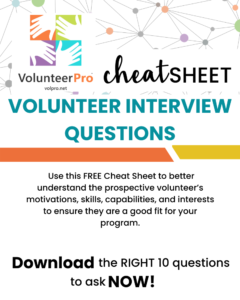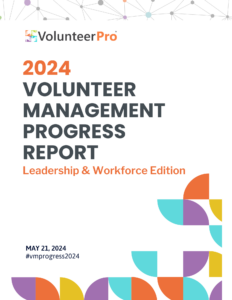Write a Volunteer Position Description that Boosts Recruitment
Your agency’s volunteer position descriptions are important tools for communications, accountability, and recruitment.
Not only do they attract the right people to your organization, but once they are there a well-written volunteer position description can map out responsibilities, expectations, and boundaries.
Here’s the thing, though. The typical volunteer position description tends to be boring and dry, so people (you and your colleagues included) are unlikely to read the entire document and know what’s expected of the role.
Instead, volunteer tasks and expectations should be written in a way that ignites their inner superheroes, not in a way that deflates their sense of what’s possible.
Every document or form you share with volunteers should deepen commitment with your cause, including volunteer position descriptions.
So, what can you create that jump starts their road to awesomeness?
Read on for 12 things every volunteer position description should include AND learn some ways you can add a bit of pizzaz to help yours stand out from the pack!
12 Things Every Volunteer Position Description Needs
Use the following information to develop an informative and inspiring document that helps volunteers understand their role and commitment to the organization and paints a picture of the successes they will help achieve.
This may seem like a lot of information, but you can include all of this in less than 2-pages if you are clear and succinct in what every role entails.
Position Title – While the position title is quite important, there is no rule that it has to be dull and boring! You want the volunteer to feel important, but not puffed up. And you want to accurately describe the role. Think of the job title as a way of distilling the entire job description down into a couple of words.
Goals of the Role – In an effort to weed out people that aren’t interested in the role, start off with a general statement of what the position is and how it relates to the overall goals of the organization.
For example, you might be looking for someone to help with your marketing campaign, yet if you don’t clarify up front what kind of marketing support you are looking for, someone with social media expertise might apply for an email marketing position and no longer be interested when they learn what the role really is in their screening interview.
Impact of the Role – Do you currently have other volunteers placed in this role? Think about that why have achieved through their work and list 3 to 5 key achievements from the past year. If it’s a new role, how will the position affect the community and the people the program serves. Think about WHY this program matters.
Duties and Responsibilities – Don’t list every task a volunteer might work on in this role. How do you know which ones to leave off? Focus only on those that are the most important. Thank about what they will spend most of their time doing in this role? Then, include a short bullet list of these specific duties, using action verbs and present tense. Don’t lump multiple tasks together to save room or cram more in there. Only describe one at a time.
Time Requirements – People lead busy lives, and even though they want to be generous with their time, you don’t want to take advantage of that generosity. Be upfront about the realistic number of hours you expect volunteers to work per week or month. Include them as a range with a minimum and maximum if it’s not for a specific shift.
Also include the length of commitment with a start and end date, if it is a project-based role. If it is an ongoing role, state the preliminary commitment (e.g., 6 months or 1 year), and then offer the chance to re-up at the end of the period.
Location – Include the primary location where the work will be performed. If the role can be performed virtually, include that it is an online volunteer opportunity, or a hybrid of in-person and online participation is possible.
If your organization has multiple locations and the role requires working out of different locations, let the volunteers know travel between locations is required. If transportation assistance is provided (e.g., free bus passes, reimbursement for mileage, carpooling, etc.) you can include that here, too.
Work Environment – Describe where the work will take place, any special tools or software that will be used, or information about physical requirements of the job. If it is a virtual volunteer role, include which key platforms will be used (e.g., we will meet via Zoom and share files using our online portal).
In this day of COVID-19 precautions, include information on how you plan to meet safe workplace requirements and what’s expected of volunteers in terms of protective equipment, vaccinations, or adjusted work schedules. This is also a good time to reinforce that you will provide training and patient support on how to use your tech tools, even for newbies.
Skills & Qualifications – List only 5-75 (10 at the very most) that are essential or desirable. You don’t need special training to answer phones, read to children, or help plan events, so don’t require it!
This is your spot to help potential volunteers find the best match for their interest area. Remember, you are not hiring paid staff, so keep expectations realistic! Focus on basic skills required of every volunteer, the technical skills related to that specific role, and any interpersonal skills that ensure the volunteer will be successful.
For example, volunteers in outreach positions (e.g., volunteers who are responsible for tabling, street outreach, or speaker’s bureaus will be most successful if they are either outgoing or willing to overcome their fear of speaking to strangers).
Orientation & Training – A lot of people look for volunteer roles that they can grow with, so, indicate that you have a plan to help volunteers grow into their roles! Explain what training the volunteer can expect to receive, through the orientation process and their tenure with you (if you offer ongoing training).
If you have dates for your orientation and training set in stone already, list them. Also, share any additional training opportunities. Are your volunteers invited to attend staff trainings? Let them know about their options to extend their breadth of knowledge!
Supervision – Add a brief statement about who will be the volunteer’s direct supervisor, whether they be paid staff or a volunteer leader, and how they will check in with their supervisor. Will they be required to meet weekly or monthly to debrief on what they accomplished? Or is once a year enough to review progress towards the goals of the role?
When you include the names of real people in your position description, volunteers are more likely, to feel less like a cog in wheel and more like an essential member of the team. And, when they do, they will be more likely to show up ready to roll!
Volunteer Benefits – Volunteers don’t necessarily get involved for the perks, but it’s nice to add any volunteer perks. Think about the perks for volunteering at your organization for each role and add them to the volunteer position description.
Recruiting for a committee leader? Perhaps a perk is making new friends. Looking for a presenter for tours of your agency? Offer a free meal to those who give up their lunch or dinner hour to join your team. Unlike a traditional job description, these perks don’t have to be monetary. In fact, they are better if they are not.
Do, however, include whether reimbursement for expenses (e.g., mileage, internet access fees, smart phone fees, bus passes, office supplies, etc.) is offered.
How to Apply – Include a link to your volunteer application or interest form. Also, include directions on where and when to submit it and what to include. Finally, include the name, phone, and email for the person or team responsible for volunteer applications. Again, the more you can highlight real people, the more personable your volunteer position description will feel and the more accountable to the role future volunteers will be.
By following these 12 recommendations, you will not only communicate your expectations and the scope of the role to future volunteers, but you will also reinforce the value of their service and set the stage for exceptional contributions of time and talent.
Why You Should Include Testimonials and Impact Statements in Your Volunteer Position Descriptions
Besides laying out what a volunteer position will look like, the main purpose of a volunteer position description is to connect with the right volunteer for the role.
In order to accomplish this, you need to really think about your messaging, your target audience, and your volunteer’s potential motivations.
You also need to spice up your descriptions with language that entices people to commit their time and talents, right away!
How can you do this?
By adding testimonials and impact statements to every position description!
Why Testimonials?
Volunteer testimonials are one of the most powerful ways to tap into the psychological phenomenon of social proof (or informational social influence). They let the community, and people who may be considering a volunteer opportunity, know that your organization is worthy of support.
When existing volunteers share information about their relationship with your program and what they have achieved, it also helps set expectations and inspire hope in newcomers.
The best time to request a recommendation is after a volunteer has experienced a positive experience with your organization.
Here are a few instances when you might want to make your ask:
-
- After an achievement Is met (meets a goal, completes a year of service, concludes an in-depth training series, etc.)
- When a volunteer thanks or compliments you, a co-worker, or your agency.
- At celebrations
- During a performance review
- As part of your exit interview
Questions to Ask
Below are some questions that are more likely to prompt a thoughtful and unique response than simply “tell us why you like us.” They will also be more interesting to those who read them. Choose a few that make the most sense at your program and ask them in short interviews or surveys.
-
- Why does this cause matter?
- Why is this cause important to you?
- What impact does your volunteer role have on the clients or community?
- What happened when you volunteered (or supported this organization)?
- How do you feel about your experience?
- What do you like most about it)?
- What does it like to be a [insert volunteer role]? How has it changed you?
- What would you say to someone might consider volunteering?
- Would you recommend this experience to others? Why?
Once you have a decent bank of testimonials, you can include them on every volunteer position description to prove the value volunteers have at your organization in this role. Also, by including testimonials you reinforce that your organization is truly worthy of a deep commitment.
Volunteer Impact Statements
As we mentioned above, by including what volunteers in this role are already doing, you add momentum by showing what’s possible.
Impact statements reflect the following:
-
- Change in Knowledge
- Change in Behaviors
- Change in Status Quo
To develop impact statements for every volunteer position at your organization, ask these questions:
-
- What do people now know as a result of their involvement in this program/service/etc.?
- What do people now do as a result of their involvement in this program/service/etc.?
- What has changed as a result of this program/service/etc.?
Once you have developed a full volunteer position description, read it as if you were a potential volunteer who knows little-to-nothing about your organization. Would the job description entice you to apply?
So, You Found Your Ideal Volunteers: What’s Next?
Thorough screening and proper placement of volunteers starts with asking the right volunteer interview questions. Although we often think about screening volunteers as a way to mitigate potential risk, it also provides a unique opportunity to better understand the motivations of the volunteer applicant.
Not sure what questions to ask?
Download our FREE Volunteer Interview Questions Cheat Sheet.
With this freebie, you’ll walk away feeling confident that you are asking the right questions to better understand the motivations, skills, capabilities, and interests of prospective volunteers to ensure they are a good fit for your organization.









